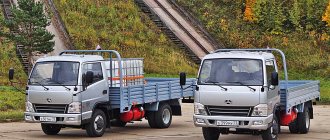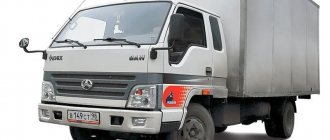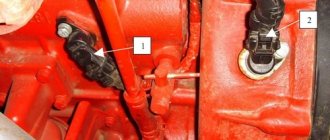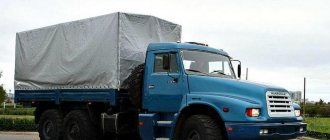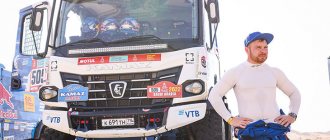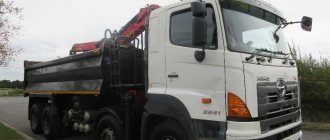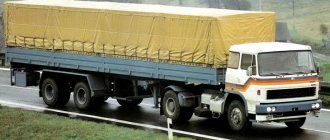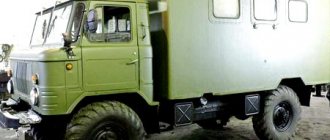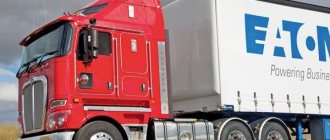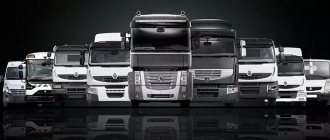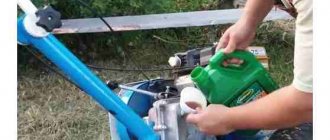Andrey Mikhailov, photo by the author
Import substitution in today's Russia is not a tribute to fashion, but an urgent necessity. The instability of exchange rates makes everyone think about how to competently replace goods purchased for foreign currency with analogues of domestic origin. The “Chinese camp” found an unexpected solution to this problem: the BAW company showed journalists its new product – the BAW-33462-102 light truck with a ZMZ gas engine.
In the ten years that the BAW brand has been represented in Russia, a lot of water has passed under the bridge. Dozens of Chinese companies entered the arena and disappeared, which, having not mastered the conquest, stopped supplies. In contrast, BAW, which has established itself through joint production in Ulyanovsk, not only confidently continues its presence, but also introduces new models developed in Russia.
The manufacturer himself suggests that the new product will be of interest to private entrepreneurs and small firms, where the cost of owning a truck, as well as its low starting price, is especially relevant. According to Andrey Lukyanov, General Director of BAU-RUS Motor Corporation, the idea of creating a gas-cylinder truck arose at the enterprise back in 2013. At the same time, it was important that the total weight of the truck did not exceed 3.5 tons in order to “fit” it into category B, and that the vehicle itself was affordable, durable and simple.
Chinese with Nizhny Novgorod
While the plant itself was undergoing technical re-equipment, the engineering corps was working on a new gas product. Having tried many options, it was decided to settle on a very unexpected one - the place in the engine compartment of the BAW-33462-102 was taken by an engine from the Volga region, model ZMZ-409061.10. It runs on liquefied petroleum gas or, more simply put, propane. At the time of development, the Volga residents did not have a ready-made solution for the required engine to meet the Euro 5 eco-standard, so they customized it on the order of the Ulyanovsk residents “outsourced”. The ITELMA industrial holding helped, which also became the supplier of the MIKAS 12 electronic control unit for the Russian-Chinese truck. The manufacturer assures that as a result, the gas engine has become 7% more powerful than its gasoline counterpart.
For the test drive, which took place at the Dmitrovsky test site, the manufacturer provided two BAW-33462-102 with different options for cargo platforms: for 6 and 8 Euro pallets, respectively. The vehicle with the larger platform was additionally loaded with 1,700 kg of ballast until fully loaded, so that the behavior of both the empty and loaded truck could be compared.
It would seem that all Asian trucks are made according to the same recipe: a cabover cab “on horseback” on the front axle, the engine is under the cab; at the back there is a large side platform.
BAW-33462-102 is no exception to this rule: it is easy to recognize the features of one of the “Japanese” cars of the nineties, which are often found on our roads today. It is typical for “Asians” - both Chinese, Korean, and Japanese trucks - that the battery hanging on the frame on the right, behind the cab, is open to all winds and prying eyes. Next to the battery is a small, only 15 liter, tank for 92-grade gasoline: on a gas car it is only needed for cold starting and warming up, so there was no need for a full tank.
On the left side is a cylinder for propane-butane: gas equipment for the Ulyanovsk enterprise is supplied by the Italian company LOVATO, well known to those who operate propane vehicles. The gas cylinder with a volume of 95 liters, installed on the truck, was produced by a Russian company based in Moscow.
BAW Fenix 33462 (formerly marked BAW Fenix 1044)
- Characteristics
- Modifications
- Reviews
- Test Drive
BAU Phoenix 33462 (1044) is a two-axle light-duty truck with an all-metal tilting cab with a cabover layout. There are two modifications of BAU Phoenix cabins: Y - single cabin and F - one and a half cabin with a berth. In both versions, the engine is located above the front axle under the truck cab.
BAU Phoenix 1044 with single Y cab
BAU Phoenix 1044 with one and a half cabin F
Technical characteristics of BAW Fenix 1044 and 33462:
- Engine type - diesel with turbocharging and intercooling
- Engine capacity - 3238 cc. cm.
- Maximum power - 103 hp. (at 3200 rpm)
- Maximum torque - 245 Nm (at 2200 rpm)
- Fuel consumption in the urban cycle - 12.8 l
- Fuel consumption on the highway - 9 l (at 60 km/h)
- Transmission - manual, 5-speed
- Maximum speed - 95 km/h
- Brake system - pneumatic, dual-circuit
- Suspension: spring with two shock absorbers
- Overall dimensions (length/width/height) - 5990 mm/2020 mm/2220 mm
More on the topic: One car, three license plates - Mercedes Atego 1223, 1224, 1222
- Curb weight - 2560 kg
- Gross weight - 3500 kg
- Load capacity - 1300 kg
Model range BAW Fenix 33462 (1044)
can be expanded by installing various add-ons. The most common modifications are:
- flatbed truck
Flatbed truck BAU Phoenix 33462 (1044)
- flatbed truck with awning
Curtainsider truck BAU Phoenix 33462 (1044)
- manufactured goods (bread) van
The BAU Phoenix 1044 (33462) manufactured goods van differs from the bread van in the absence of guides for installing bread trays
- isothermal van and sandwich van
Isothermal van BAU Phoenix 33462 (1044)
- there are options for BAU Phoenix 1044 with a manipulator (KMU)
Loader crane BAU Phoenix 1044 (33462)
Reviews of BAW Fenix 1044 (33462)
Before you buy a new BAU Phoenix 33460 or a used BAU Phoenix 1044, you need to carefully study all the advantages and disadvantages of these cars. Not only detailed technical specifications of the BAW Fenix 33460 (1044) and reviews from owners, but also recommendations from service station specialists servicing Chinese cars can help with this. This is the only way to find out the whole truth about BAU Phoenix.
In addition, the following video review will help you find out the main advantages and disadvantages of the BAW Fenix 1044:
Inner world
The driver's seat greets you with two news: good and not so good. The good news is that you can get relatively comfortable behind the wheel: the driver’s seat is adjustable longitudinally and for backrest tilt (although you have to search for a long time for the longitudinal adjustment lever under the seat), and the steering column is adjustable for reach and tilt. The bad news is that the position remains unnatural due to the strange pedal assembly: if you are not used to it, there is a risk of pressing the gas and brake pedals at the same time. Drivers who brought cars from the factory refer to the fact that they did not have time to “bend the pedal”, supposedly there is room for improvement; however, it is better to find a solution to the problem by the manufacturer himself in order to avoid “on-site” experiments in the future.
The two passenger seats are much simpler in shape and not as comfortable. The main feature is the folding backrests: the middle seat has a lockable storage compartment, a paper tray and two cup holders, and the outer seat on the right can be folded if there is a need to sleep in the cabin.
The interior is made of simple materials, which is quite forgivable in a cheap car. At the same time, which is uncharacteristic for the “Chinese”, the finishing materials in BAW do not greet the cabin with a pungent chemical aroma - this is a noticeable step forward relative to its fellow competitors. The instrument cluster looks modest, but not bad: large dials for the speedometer and tachometer, between them there is a block of indicator lamps and a display that displays the odometer and power reserve.
An unpleasant little thing is that the glove box and pockets in the doors are too small for documents of forwarders and drivers, so the papers are carried behind the driver’s visor. The new BAW, with its gray plastic modesty, stands out positively from its relatives, where the interior greets with a strong chemical aroma and plastic wood veneer. The issue of ventilation in the cabin was solved in a rather original way: a small lifting hatch was made in the roof, adjustable with a “twist” on the ceiling.
There is no access to the engine compartment from the cab: to perform most simple operations, the cab will need to be raised using a pair of levers behind it. Except that a couple of tanks with technical fluids are modestly located under the edges of the instrument panel. Their filler necks are covered with decorative caps in the panel, which will soon be lost - they are not secured by anything and will need to be held in your hands when refilling.
Let's talk our way
The empty BAW that I got is surprisingly nimble for a gas car: it accelerates confidently, the gears are engaged unexpectedly for a “Chinese” clearly, and it confidently goes up hills in both IV and V gears. The car itself, thanks to the layout and power steering, is nimble and maneuverable, but after 80 km/h it begins to noticeably roll when cornering. On older Phoenixes the brakes were pneumatic-hydraulic, but now they are fully hydraulic, dual-circuit with a vacuum booster and a brake force regulator. But it was the brakes that presented another fly in the ointment on the pedal side: the first third of pressing does not cause any reaction from the truck, so you have to get used to pressing the pedal harder. The second car, loaded with ballast, although it crawls up the hill less willingly, still drives quite cheerfully: we are clearly not talking about the carrying capacity of 1700 kg indicated in the documents, but much more in fact. This is directly hinted at by the dimensions of the side platforms, 7-leaf springs and a durable U-shaped riveted frame. But fines for overloading, which is inevitable in such cases, will not be the concern of the manufacturer at all.
The side platforms on the tested trucks are so far made in China, although one vehicle already has a sign of a Russian superstructure manufacturer; under the gray paint, the “all-Chinese” blue color clearly appears on the scuffed sides. So far, in Ulyanovsk they have really mastered the production of vans on their own chassis - on the same site with bus bodies, and full-fledged localization of the production of on-board platforms is planned for 2016.
Undoubtedly, the gas BAW will find its buyer: first of all, it is a small company engaged in transportation within the city, which will be attracted by the “advantages” of the Russian-Chinese truck relative to its competitors. In the current market situation, Ulyanovsk residents are not taking on super-tasks: for now they are targeting 10% of the segment (about 700–800 cars per year) with an existing production capacity of 2,500 cars per year. Depending on the stabilization of the market over time, production can be expanded up to 25,000 cars per year - the site and investment program allow it to grow to such a level in a stable future.
BAW Fenix 33460 (formerly BAW Fenix 1065)
- Characteristics
- Modifications
- Reviews
- Video review
The BAW Fenix 33460 (1065) is a medium-duty truck used primarily for intercity cargo transportation.
BAU Phoenix 1065 (33460)
With a similar layout to the BAU Phoenix 33462 (1044), the main differences of the model 33460 (1065) are:
- increased load capacity
- increased volume and area of the body
- increased platform length
- wide cabin
Technical characteristics of BAU Phoenix 33460 (1065):
- Engine type - diesel with turbocharging and intercooling
- Engine capacity - 3163 cc. cm.
- Maximum power - 120 hp. (at 3200 rpm)
- Maximum torque - 300 Nm (at 2100 rpm)
- Fuel consumption in the urban cycle - 13.6 l
- Fuel consumption on the highway - 10.2 l (at 60 km/h)
- Transmission - manual, 5-speed
- Maximum speed - 95 km/h
- Brake system - pneumatic, dual-circuit
- Suspension: spring with two shock absorbers
- Overall dimensions (length/width/height) - 6990 mm/2200 mm/2220
- Curb weight - 2845 kg
- Gross weight - 6490 kg
- Load capacity - 4000 kg
More on the topic: Foton trucks are good vehicles for private transportation at affordable prices
Modifications BAW 33460 (1065)
By analogy with the younger model, chassis 33460 has many different add-ons that allow you to build on the basis of the BAW Fenix truck:
BAU Phoenix 1065 (33460) chassis
- tow truck
BAU Phoenix 1065 (33460) tow truck
- manufactured goods or isothermal van
BAU Phoenix 1065 (33460) van
- dump truck
BAU Phoenix 1065 (33460) dump truck
- tank
BAU Phoenix 1065 (33460) milk tanker
- or equip it with a crane
BAU Phoenix 1065 (33460) with a crane
Reviews of BAW Fenix 1065 (33460)
Reviews of Chinese cars BAW Fenix 1065 and 33460 are also in many ways similar to reviews of models 1044 and 33462. But thanks to the increased dimensions of the older model, the number of complaints about insufficient capacity, low ride comfort, small size of the sleeping compartment and an inconvenient instrument panel has decreased. At the same time, such disadvantages as are typical for BAU Phoenix vehicles remain, such as low cabin noise insulation, an inefficient heating system, difficult engine starting at low temperatures, low reliability of individual parts and the high cost of their replacement. Despite the existing shortcomings, there are often reviews from owners who carry out long-distance transportation with the BAU Phoenix 1065, whose vehicles have traveled hundreds of thousands of kilometers.
This review video will help you form your own opinion about the BAW Fenix 1065:
Localization issues
It would be a lie to say that BAW trucks are only assembled in Ulyanovsk.
Now this is a full-fledged, fairly powerful production with large reserves, which has achieved widespread localization of its products. The Russian BAW plant does not participate in the industrial assembly program, which gives manufacturers certain preferences from the state: the adaptation of domestic components and assemblies is carried out primarily in order to simplify the life of consumers in purchasing spare parts. According to the manufacturer, the serial BAW truck has already been localized by 63% - today in Ulyanovsk they are welding and painting cabs from stamped elements coming from China, installing Russian glass, wheel assemblies, an exhaust system, a fuel tank and much more. The level of localization, according to the manufacturer, will increase in the near future: first of all, due to the installation of domestic gearboxes, driveshafts, axles and springs, and most importantly, Russian-made engines. The manufacturer is already declaring plans to adapt the ZMZ-514 diesel engine and a methane engine supplied from the Volga region. According to the company’s new policy, it has announced a transition from the BAW brand to a new name, “originally Russian” and “associated with the city of Simbirsk”: it is now undergoing registration, but for now it is known that diesel trucks will be part of the Fenix family, and gas trucks will be peGAS.
